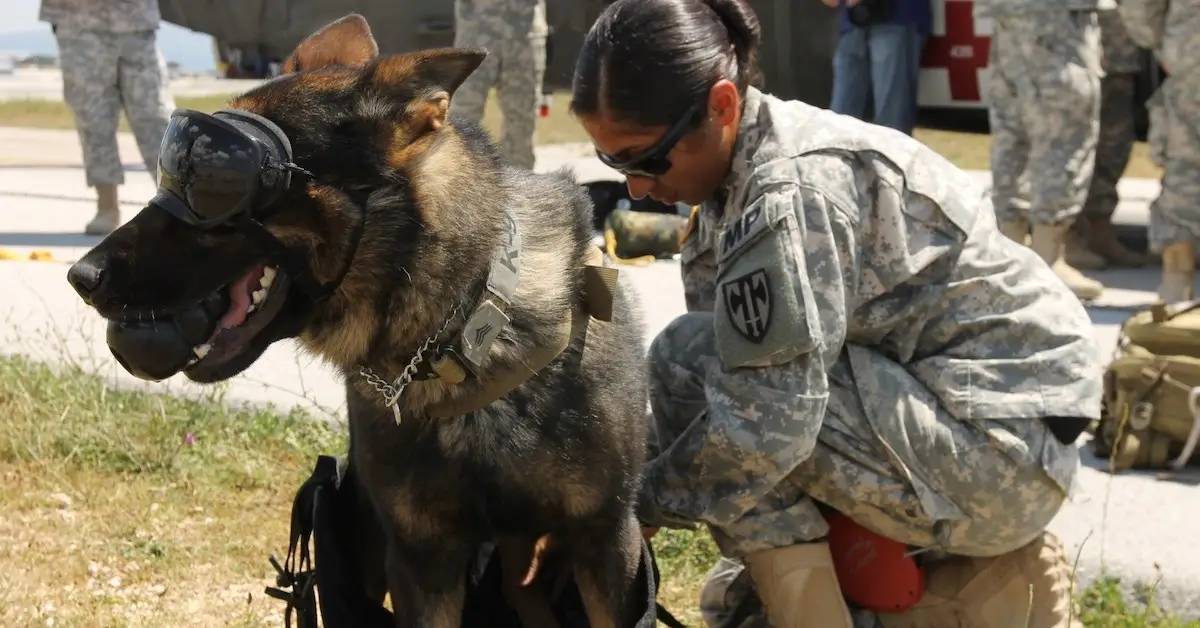4 missions of the military working dog

SUMMARY
"The relationship between a military working dog and a military dog handler is about as close as a man and dog can become. You see this loyalty, a devotion unlike any other, and the protectiveness."
– Robert Crais
The United States military has utilized working dogs since the Revolutionary War. They were originally used as pack animals, carrying as much as forty pounds of supplies between units, including food, guns and ammo. Then during World War I, they were used for more innovative purposes, like killing rats in the trenches. However, it was during World War II that there was a surge in the use of military working dogs. The U.S. military deployed more than 10,000 working dogs throughout WWII. These specially trained dogs were used as sentries, scouts, messengers, and mine detectors. It is estimated that there are approximately 2,300 military working dogs deployed worldwide today.
The military working dogs of today are utilized in many different missions and specialties. After intensive training, each dog is then assigned to a specific specialty based on their strengths and abilities. Once the military working dogs are assigned their specialty, they are shipped out to military installations worldwide.
Here are a few of the possible specialties these military working dogs can be selected for
1. Sentry dogs
Sentry dogs are trained to warn their handlers with a growl, bark, or other alert when danger or strangers are nearby. These dogs are valuable assets, especially for working in the dark when attacks from the rear or from cover are the most likely. Sentry dogs are often used on patrols, as well as guarding supply dumps, airports, war plants and other vital installations.
2. Scout/Patrol dogs
Scout and patrol dogs are trained with the same skills that sentry dogs are. However, in addition, these dogs are trained to work in silence. Their job is to aid in the detection of ambushes, snipers, and other enemy forces. These particular dogs are somewhat elite among the military working dogs, because only dogs with both superior intelligence and a quiet disposition can be selected for this specialty. Scout and patrol dogs are generally sent out with their handlers to walk point during combat patrols, well ahead of the Infantry patrol.
3. Casualty dogs
Casualty dogs are trained in much the same way search and rescue dogs are. They are utilized to search for and report casualties in obscure areas, and casualties who are difficult for parties to locate. The time these dogs save in finding severely injured persons can often mean the difference between life and death.
4. Explosive detection
With the current war on terrorism, explosives hidden on a person, in a vehicle, or in a roadside location is a common threat. Explosive detection dogs are trained to alert their handlers to the scent of the chemicals that are commonly used in explosives. These dogs have such a superior sense of smell that it is nearly impossible to package explosives in a way that they cannot detect.
No matter what their specialty or their mission, the reality is these highly trained K9s are an invaluable part of today's military. There has yet to be a technology created that can match the ability and heart that military working dogs sustain every day. These dogs are the unsung heroes of the U.S. military, and it is only in recent years that there has been a movement to make sure they are given the appreciation and benefits they deserve. There is constant research going into the best ways to protect them in combat. And along with a push to make K9 Veterans Day an official holiday, there is also a movement to make sure these four-legged heroes are taken care of when their time in service comes to an end.
SHARE
